Wallflowers of the Earth system

Lichen on a twig. The photo shows various lichen species that have colonised a twig. Lichens as the common orange lichen (Xanthoria parietina) are a symbiosis of a fungus and green or blue green algae (cyanobacteria). They belong to the cryptogamic covers that can fix carbon dioxide and nitrogen depending on the species. Picture: W. Elbert, MPI for Chemistry<br>
In cities, the presence of algae, lichens, and mosses is not considered desirable and they are often removed from roofs and walls. It is, however, totally unfair to consider these cryptogamic covers, as the flat growths are referred to in scientific terms, just a nuisance.
Scientists at the Max Planck Institute for Chemistry have discovered that these mostly inconspicuous looking growths take up huge amounts of atmospheric carbon dioxide and nitrogen and fix it at the earth’s surface. Cryptogamic covers are responsible for about half of the naturally occurring nitrogen fixation on land and they take up as much carbon dioxide as is released yearly from biomass burning. These new findings will help to improve global flux calculations and climate models, in which up to now the carbon and nitrogen balance of the cryptogamic covers have been neglected.
The roles that forests and oceans play in the climate and in the global exchange of oxygen, carbon, and nitrogen have been documented in numerous scientific studies. The importance of algae that grow on land, lichens, and mosses for the nitrogen and carbon fluxes and also for the carbon dioxide balance is normally not taken into consideration. This even though cryptogamic covers including the blue green algae (cyanobacteria) cover approximately 30% of soil surface that includes the surfaces of plants. Life forms that get their energy through photosynthesis, but don’t flower, belong to the cryptogams. They are found in all ecosystems, not just on roofs, trees, or walls. Cryptogamic covers, which consist of some of the oldest life forms on our Planet, are also found on cliffs and in soils in dry regions.
“Actually, we wanted to know which compounds the cryptogamic covers emit into the air“, said Wolfgang Elbert, who initiated the research at the Max Planck Institute of Chemistry. “We found that there are a lot of studies about the ecological role of these life forms, but their contribution to the global nitrogen and carbon balance has been neglected until now.“ To get at the importance of the cryptogamic covers, the chemists analysed the data from hundreds of studies in cooperation with biologists and geologists. Their finding: Algae, mosses, and lichens take up approximately 14 billion tons of carbon dioxide and fix approximately 50 million tons of nitrogen per year.
Kryptogamic covers are ecologically important especially as they fix nitrogen
The magnitude of these numbers surprised the Mainz´ researchers and their colleagues at the University of Kaiserslautern and the Biodiversity and Climate Research Centre in Frankfurt because the cryptogamic covers take up about as much carbon dioxide as is annually released by the burning of forests and other biomass.
Especially amazing is the amount of nitrogen that is fixed by the cryptogams and that is thereby made available in the soil and to other organisms. “This represents half of the naturally fixed nitrogen on land, which is of particular importance for ecosystems because nitrogen is often the limiting nutrient. Also, the uptake of CO2 by plants is often limited by the availability of nitrogen“, explained Ulrich Pöschl, leader of the research group.
The results support that crytpogamic covers are an important nitrogen source especially in nutrient-poor ecosystems and dry regions and that they promote the fertility and stability of ground surfaces. (SB/PH)
Original publication
Wolfgang Elbert, Bettina Weber, Susannah Burrows, Jörg Steinkamp, Burkhard Büdel, Meinrat O. Andreae and Ulrich Pöschl
Contribution of cryptogamic covers to the global cycles of carbon and nitrogen
Nature Geoscience, June 3rd 2012; DOI: 10.1038/NGEO1486
Media Contact
More Information:
http://www.mpic.de/All latest news from the category: Life Sciences and Chemistry
Articles and reports from the Life Sciences and chemistry area deal with applied and basic research into modern biology, chemistry and human medicine.
Valuable information can be found on a range of life sciences fields including bacteriology, biochemistry, bionics, bioinformatics, biophysics, biotechnology, genetics, geobotany, human biology, marine biology, microbiology, molecular biology, cellular biology, zoology, bioinorganic chemistry, microchemistry and environmental chemistry.
Newest articles

Microscopic basis of a new form of quantum magnetism
Not all magnets are the same. When we think of magnetism, we often think of magnets that stick to a refrigerator’s door. For these types of magnets, the electronic interactions…

An epigenome editing toolkit to dissect the mechanisms of gene regulation
A study from the Hackett group at EMBL Rome led to the development of a powerful epigenetic editing technology, which unlocks the ability to precisely program chromatin modifications. Understanding how…

NASA selects UF mission to better track the Earth’s water and ice
NASA has selected a team of University of Florida aerospace engineers to pursue a groundbreaking $12 million mission aimed at improving the way we track changes in Earth’s structures, such…





















